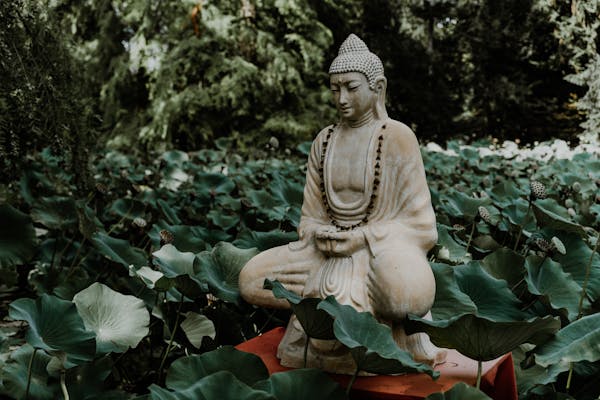Table of Contents
1. Introduction
Buddhism and meditation are intrinsically connected, forming the foundation of a spiritual journey that has transformed lives for centuries. Meditation in Buddhism is not merely a practice but a way of life that aims to cultivate mindfulness, self-awareness, and inner peace. One of the most profound meditation techniques in Buddhism is Vipassana, or “insight meditation,” which offers a pathway to understanding the true nature of reality.
This blog delves into the art of Vipassana, exploring its origins, principles, and practical applications in modern life.
Understanding Buddhism and Meditation
What is Buddhism?
Buddhism is a spiritual tradition founded over 2,500 years ago by Siddhartha Gautama, known as the Buddha. At its core, Buddhism teaches that suffering arises from attachment and ignorance, and liberation can be achieved through understanding and ethical living.
The Buddha’s teachings, encapsulated in the Four Noble Truths and the Eightfold Path, emphasize mindfulness, wisdom, and compassion.
Meditation in Buddhism
Meditation is one of the most important elements in Buddhism and is used to calm the mind and to get insight into the nature of existence. The two major forms of Buddhist meditation are as follows:
Samatha (Calm-Abiding): Focuses on concentration and tranquility, which can often be achieved by focusing on the breath.
Vipassana (Insight): Involves observing thoughts, sensations, and emotions to gain a deep understanding of impermanence and interconnectedness.
Through these practices, Buddhism and meditation together provide a journey of self-discovery and enlightenment.

2. What is Vipassana?
Definition and Meaning
Vipassana, from the Pali word meaning “to see things as they are,” is a technique of insight meditation. Vipassana differs from other methods that work to quiet the mind; Vipassana encourages observers to view inner experiences objectively, allowing deeper understanding of reality.
History of Vipassana
It finds its origin in Gautama Buddha’s teachings. According to Pali Canon, the first known writings of Buddhism, Vipassana is a way for practicing mindfulness and insight. Since the ancient times of preservation in Myanmar and Sri Lanka, Vipassana has been rediscovered with teachers like S.N. Goenka spreading this globally.
3. Practising Vipassana Meditation
Essential Principles
Vipassana focuses on observing the impermanence of sensations, thoughts, and emotions. The practice involves:
Being aware of bodily sensations without judgment.
Understanding that all experiences arise and pass away, revealing their transient nature.
Steps in Vipassana
Begin with Anapana (Mindfulness of Breathing):
Sit comfortably and focus on your breath, observing it naturally without altering its rhythm.
Transition to Insight Observation:
Gradually shift your attention to bodily sensations, scanning the body systematically.
Maintain Equanimity:
Observe without reacting, regardless of whether the sensation is pleasant, unpleasant, or neutral.
Practice Daily
Starting with 10–15 minutes a day, it can lay the base for longer sessions. In fact, consistency is paramount in incorporating Vipassana into daily life.


4. Benefits of Vipassana Meditation
Spiritual Benefits
Vipassana increases mindfulness and leads the practitioner to a deep perception of the impermanence of life. It allows practitioners to align themselves to the Buddhist goal of reduction of suffering by detaching from cravings and aversions.
Mental and Emotional Advantages
Eliminates tension, worry, and the negative mind streams.
Improves emotional intelligence, stress tolerance, and awareness of the mind.
Physical Benefits
Research by scientists show that Vipassana has beneficial impacts on the body, including a refreshing sleep, lowered blood pressure, and alleviated impacts of stress diseases.
Integration of Buddhism and Meditation in Vipassana allows it to present the best means to lead a well-balanced life between the realms of spirituality and material existence.
Vipassana Courses: Total Retreat End
What Goes On in a Vipassana Retreat?
Vipassana retreats come in 10 days sessions, which create an opportunity for intense learning and mastering the technique. In fact, silent retreats take participants through a schedule and activities that include:
Avoid speaking, reading, or playing with devices.
Observance of a very tight plan of meditation and mindfulness observances.
Ethical prescriptions, such as avoiding any form of lying or causing harm.
Well-known Vipassana Centers
Famous Vipassana centers are present all over the world; many of them are found in India, which is the land of origin of Buddhism and meditation.
Preparation for a Retreat
Preparation is both in the mind, in preparation to sit in silence, and the body, in terms of physical adaptation to longer sitting. Newcomers are advised to begin with shorter periods before going on a retreat.


5. Vipassana in Modern Life
Relevance Today
In the turmoil of modern life, the philosophy of Buddhism and meditation is a haven. Vipassana teaches people to deal with problems calmly and in equilibrium, thus being able to respond wisely instead of reacting instinctively.
Incorporating Vipassana into Daily Life
Practice mindfulness while doing routine things, like eating, walking, or working.
Take short meditation breaks throughout the day to reconnect with yourself.
Even a few minutes of Vipassana each day can build up the awareness to better face the difficulties of life.
6. Challenges and Misconceptions
Misconceptions
Vipassana is only for monks: Vipassana is universal, appropriate for any background of culture and religion.
Meditation is to stop thinking: Vipassana encourages the awareness of thoughts but does not require them to be suppressed.
Challenges for the practitioner
At first, a practitioner usually feels restlessness or boredom.
Maintaining a regular practice can be challenging, especially in a busy schedule. These challenges are to be overcome with patience, discipline, and gradual progress.
Sure! Here’s an extended elaboration to ensure the blog fully explores its concepts, fills out the word count, and keeps Buddhism and meditation as a recurring theme:
7. The Philosophy Behind Buddhism and Meditation
In order to understand Vipassana, one must first understand the philosophical foundation of Buddhism and meditation. Buddhism teaches that life is characterized by impermanence (Anicca), suffering (Dukkha), and non-self (Anatta). These three characteristics of existence are essential to the practice of meditation.
Vipassana allows practitioners to witness these truths firsthand in their own lives. Through meditation, they learn how attachment, craving, and aversion cause suffering. According to the Buddha, “Peace comes from within. Do not seek it without.” Vipassana meditation allows this peace to become a reality by creating an accepting and equanimous mind.
How Vipassana Reflects the Buddha’s Teachings
Vipassana reflects the teachings of the Eightfold Path, specifically:
Right Mindfulness (Samma Sati): Being in the present and aware of thoughts, emotions, and sensations.
Right Concentration (Samma Samadhi): Developing mental focus to observe reality clearly.
With the harmony of Buddhism and meditation, practitioners not only gain insight but also incorporate virtues such as compassion, patience, and non-attachment.
Scientific Perspectives on Vipassana Meditation
While Vipassana has ancient roots, modern science has validated its benefits. Neuroscientific studies reveal that consistent meditation can lead to:
Improved Brain Function: Regular Vipassana practice enhances the prefrontal cortex, improving focus and emotional regulation.
Reduced Stress: Meditation reduces cortisol levels, alleviating symptoms of anxiety and depression.
Enhanced Neuroplasticity: Vipassana fosters the brain’s ability to adapt and rewire, which can break negative thought patterns.
Scientific studies also show the congruence of Buddhism and meditation with modern mindfulness-based therapies, like Mindfulness-Based Stress Reduction (MBSR). Vipassana is a spiritual as well as practical method for self-development.
8. Vipassana Compared to Other Types of Buddhist Meditation
Vipassana vs. Samatha (Calm-Abiding Meditation)
Objective: Samatha aims at calm abiding, whereas Vipassana is more about insight and awareness.
Technique: In Samatha, meditators focus on a single object such as the breath to attain tranquility. Vipassana is moving beyond tranquility and realizing the impermanent nature of all phenomena.
Experience: Vipassana is an active process of observation, so it’s a dynamic and transforming practice.
Vipassana vs. Zen Meditation (Zazen)
Zazen stresses “just sitting” with awareness, while Vipassana includes methodical body scans.
Both illustrate the timeless relationship between Buddhism and meditation but have a better fit for one type of temperament and end in view.
9. Practical Tips for Starting Vipassana Practice
1. Set Realistic Goals
Start small. A 10-minute daily meditation is a manageable way to introduce Vipassana into your life. Over time, gradually increase the duration.
2. Create a Dedicated Space
Choose a quiet spot where you can sit comfortably without distractions. This reinforces consistency and focus.
3. Be Patient with the Process
Vipassana requires time and effort. Beginners may encounter restlessness or discomfort, but persistence is key.
4. Learn from Authentic Sources
Attend a certified Vipassana retreat or learn from authentic teachers who focus on the original teachings of Buddhism and meditation.
5. Bring Mindfulness into Daily Life
Be present even off the meditation cushion. Practice mindfulness while eating, walking, or working to carry the insights of Vipassana into daily activities.


10. How Vipassana Supports Ethical Living
This aspect sometimes overlooked about Vipassana is its ethical cultivation. The Buddhist way leads to enlightenment, which then is combined with morality or good behavior. Through these practices, the person sees interconnectedness, cultivates nonviolence by recognizing potential harmful activities or thoughts, and promotes integrity through honesty and the authenticity that mindfulness cultivates.
By embracing Buddhism and meditation, individuals transform their inner world and contribute to a more harmonious and compassionate society.
Conclusion
The journey of Buddhism and meditation is exemplified by Vipassana, which has always been a timeless pursuit towards self-awareness and liberation. Observing the impermanence of life is possible through Vipassana, thus allowing an individual to transcend suffering and unveil their true essence. From daily practice to immersion retreats, Vipassana offers a path towards mindfulness, peace, and clarity.
If you’re ready to embark on this transformative journey, remember that the practice begins with a single breath. Embrace the art of Vipassana, and experience the profound connection between Buddhism and meditation in your own life.
